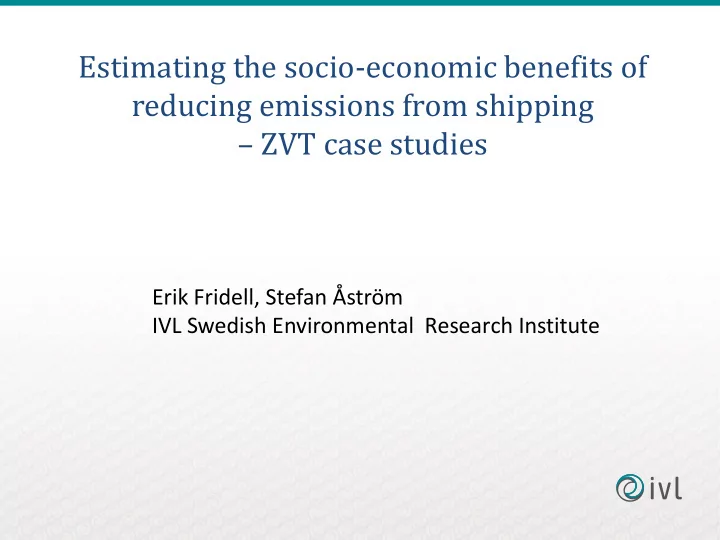

Estimating the socio-economic benefits of reducing emissions from shipping – ZVT case studies Erik Fridell, Stefan Åström IVL Swedish Environmental Research Institute
Key messages Air pollution and Greenhouse gas emission reductions are associated with improved human health conditions and decreased impact on climate change Human health conditions and decreased impact on climate change can (and is often) monetized to enable weighting between benefits and costs for society of reducing emissions In our case studies, reduced emissions from individual ships can be associated with socioeconomic benefits for Europe in the ranges of 563 – 862 thousand euros annually
Why did we perform these calculations? European emissions of air pollutants are recognised to cause negative environmental and health impacts Within the ZVT network there are initiatives to build and use ships with lower emissions and lower health impacts than required by legislation To use a common metric (money) often facilitates discussions and can make the costs for reducing emissions comparable with the benefits
How did we perform the calculations? Three case studies: – Case study 1 – BalticSO2lution vs. Reference ship – Case study 2 – LNG-Conv. vs. Reference ship – Case study 3 – Pilot Methanol vs. Reference ship Emission calculations: Emission = emission factor*fuel use Emission dispersion from sea regions to countries Calculations of human health impacts & crop impacts Monetisation of human health impacts & crop impacts & climate change impacts
Emission calculations - method Traffic and fuel consumption assessed by shipowner Emission factors from literature Calculations for – Nitrogen oxides – Particulate matter – Sulphur oxides – Greenhouse gases as CO2-equivalents (CO2, methane, nitrous oxide)
Results - emissions Case study 1: BalticSO2lution vs. Reference ship (1&2) Emissions Emission reduction Baltic Reference Reference low high SO2lution ship 1 ship 2 CO 2eq 1 5 kton SO 2 4 7 ton CO 2eq 7 12 8 kton 156 235 ton NO X SO 2 1 7 5 ton PM 2.5 5 7 ton NO X 43 278 199 ton PM 2.5 1 9 6 ton Fuel use 113 161 113 TJ SECA compatible? yes yes yes NECA compatible? yes NO NO We assumed 65% of emissions in the Baltic Sea
Calculation of human health impacts The GAINS model is used to calculate population exposure to fine particulate matter in air caused by human activities These exposure data are transferred to the AlphaRiskpoll (ARP) model The ARP model is used to calculate human health impacts – Knowledge on human health impacts gathered from epidemiological studies that have identified relationships between human health and concentrations of fine particulate matter
Results – Socioeconomic benefits Case study 1: BalticSO2lution vs. Reference ship (1&2) Monetized annual benefits – central estimate (low & high) BalticSO2lution vs. BalticSO2lution Reference ship 1 vs. Reference ship 2 Human Health 1092 (511-2550) 724 (339-1691) thousand € Crop damages 25 17 thousand € Climate change 110 (31-320) 25 (7-72) thousand € TOTAL 1227 (567-2896) 765 (362-1780) thousand €
A final note on the models used The GAINS, EMEP, and AlphaRiskpoll models are used by the European Commission to give decision support analysis for EU air quality policies All these models have been extensively documented and reviewed The GAINS model: – http://gains.iiasa.ac.at/models/index.html The EMEP model: – http://emep.int/mscw/index_mscw.html The AlphaRiskpoll model (not open for public use): – http://www.ec4macs.eu/content/report/EC4MACS_Publications/MR_Final%2 0in%20pdf/Alpha_Methodologies_Final.pdf
Recommend
More recommend